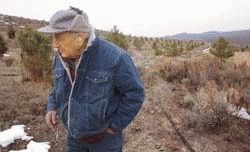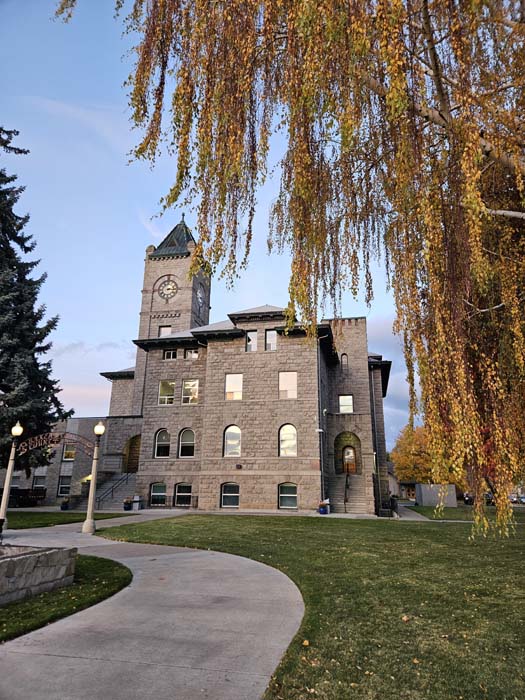Local Man Creates Forest in the Desert
Published 12:00 am Friday, March 23, 2001

- Sid Johnson surveys a stand of ponderosa pines he planted about six years ago on a slope that before supported only sagebrush, grasses and an occasional juniper. Running along the ground to Johnsons right is a plastic pipe that carries water from a nearby pond to each of the trees. (Baker City Herald photograph by S. John Collins).
By JAYSON JACOBY
Of the Baker City Herald
ALDER CREEK Sid Johnson has built houses for many decades, but the foundation to which he has dedicated his heart is for a forest.
Of ponderosa pines.
And Douglas-firs.
And western white pines and Engelmann spruces and lodgepole pines and even a couple of giant sequoias.
Oh, and tamaracks, too, except Johnson, who knows his trees by the book as well as by the bark, uses the formal name western larch, rather than the colloquial.
He has planted them all at his place on Alder Creek 5,000 all told over the past 25 years and he can walk through their groves and seemingly tell you a story about each one.
He can reminisce about the pine he found while hunting deer over in Dark Canyon, how he hauled the tiny tree home with its hair-thin roots cradled in a milk carton. Now its 15 feet tall.
There is a similar story with many of Johnsons trees, dozens of which he brought back to Alder Creek from as many distant ridges, handling them always with care, like so many papooses.
He dug the holes, and before he returned them to the ground he baptized the little trees roots in mycorrhizal fungi, which is supposed to aid the roots ability to absorb precious water and nutrients.
And when nature turned harsh and uncaring Johnson brought that water to his forest himself, lugging it in tendon-straining five-gallon buckets.
That got old pretty fast, Johnson said.
So he spent tens of thousands of dollars to excavate ponds that store water from the creek, and from an occasional seep, and from the snowmelt freshets that wash the land every spring.
And then he laid miles of one-inch diameter plastic pipe to carry that water, and he attached to it hundreds of short lengths of spaghetti-like strands so that every tree has its own little faucet.
Every year Johnson adds to his foundation of conifers, replacing trees lost to gophers and cottontail rabbits and the cruel heat of August.
He does all these things, and dozens more that are equally unglamorous but arduous even so, knowing he will not see this forest at its grandest, when the ponderosas puzzle-piece bark is thick and fragrant and the firs trunks tall and straight.
Why, then, does a 76-year-old continue to toil at such a task?
His wife asked him, for one thing.
Johnson has roots at Alder Creek deeper than any of the 5,000 trees he has planted here.
His grandparents and father moved from Wisconsin to Baker County in 1911.
The family settled at Alder Creek, about 15 miles southeast of Baker City, and thats where Johnsons parents brought their infant son after he was born in 1924 at the old St. Elizabeth Hospital.
In the years before the Depression, Johnsons family owned about 1,000 acres, cultivating the land to hay and grain, and raising some milk cows besides.
The family lived at Alder Creek until Sid was a seventh-grader; then they moved to Muddy Creek.
Johnsons parents never regained their original homestead, but after the Depression they bought 160 acres nearby, and so Johnson continued to visit Alder Creek, to hunt deer and explore the draws filled with sage and scattered junipers.
Eventually the property became his.
Johnson has bought two adjoining parcels since then about 70 acres around 1980, then 510 acres in 1995.
But the truly epochal event occurred back around the early 1970s.
Johnson was talking with his wife, Nancy, whom he married in 1948.
She made a casual remark that has profoundly affected her husbands life in the nearly three decades that have passed since. Johnson doesnt remember the actual words, but it came down to something like this: Id like to see some trees around.
And she wasnt referring to junipers, Johnson says now. I decided I could plant a few trees and satisfy her requirements.
Nancy Johnsons request sounded simple, but actually it confronted her husband with the sort of challenge that can drive a forester to insomnia.
Alder Creek, at least in its lower reaches along which the Johnsons property lies, is a place where a cabal of forces conspires to kill conifer trees, not nurture them.
Shade to shelter fragile seedlings from the suns broiling heat is rare, and rainfall to moisten their tender roots almost as uncommon.
In a typical year, the combination of rain and melted snow here totals little more than 10 inches barely enough to sustain a juniper, perhaps the toughest tree of all, and utterly insufficient for common conifers such as pines, firs and spruces.
Probably the only place in Oregon where groves of ponderosa pine survive similar climatic conditions without help from humans is at the Lost Forest, not far from Christmas Valley in northern Lake County.
But the geology there is unique, consisting of a porous layer of sandy topsoil, which allows the scant precipitation to soak in, underlain by clay that holds most of the moisture at a level where the pines roots can get to it.
Nature has provided Johnson none of these advantages at Alder Creek.
He had to create them himself.
Otters and sunsets.
The rewards for his labor, Johnson has learned, vary as widely as cloud patterns.
The river otter visited the pond just down the hill from the house the Johnsons built on their place several years ago.
Johnson writes down every species of animal and bird hes seen on his property; the list continues across several pages of lined notebook paper.
The house is a postcard kind of place, perched on a knoll with a panoramic view to the west.
Spectacular defines the sunsets here, so much so that a writer seeking to describe the grandeur of the event without wearing out that adjective would need to extract all the riches of the thesaurus.
When Johnson isnt pruning limbs, or measuring growth rates on one of the 150 trees he tagged for that purpose, or tinkering with his irrigation system, he can relax on the porch swing or on the sofa and enjoy this forest, which looks as unlikely now in this arid spot as the very idea of its existence seemed a quarter-century ago when he tamped down the soil around the very first seedling.
But then Johnson always has seen more in this land than the casual observer might.
This is apparent both in the widest sense he looked at hundreds of acres of drought-tolerant sagebrush and envisioned a forest of water-swilling conifers and to the level of the smallest detail the way a gnarled old juniper, felled to free water for the trees Johnson planted, if cut properly at the stump makes a fine stool.
The ponds, too, have more than a single role in winter, when the trees dont need to be watered, their frozen surfaces give Johnsons grandchildren a fine place to play ice hockey.
Of course, taking care of the familys investment here has Johnson at work much more than hes at rest.
The job he has created for himself is much different from that of the average planter of trees, who toils mostly in fecund soils and, having dropped the seedling into the ground, can walk away and leave nature to supply the nurturing mixture of sun and rain.
No, this forest at Alder Creek couldnt have lived were it not for Johnsons vision and efforts, and it probably would not survive if he were to turn away now.
Certainly the trees would not thrive as they have.
The ponderosa pines would not add more than a foot of growth in a single year without the water that Johnsons ponds and pipes provide the roots.
But then Johnson never intended his work at Alder Creek to be anything but a lifelong pursuit.
It is, really, that rarest of things: a difficult job that doesnt seem so; a back-breaking task that beckons.
It keeps me busy, Johnson said. And it was also a challenge to see if I could raise trees under these conditions.
He has proven both that it is a challenge, and that it is possible.
Wood has been to Johnsons life as the sea is to a sailors.
He thinks about this sometimes.
He thinks about the hundreds of thousands of board-feet of lumber he sawed and nailed together to create homes and offices, and the trees that had to fall.
And he thinks about the wood he is growing now, about putting something back and leaving the place better than he found it, as he puts it.
In these concepts Johnson finds more than ample reason to continue investing so much of his time and money here.
It is why he surrounds his tender new seedlings with wire cages to thwart hungry deer.
Why he stocks his shed with a selection of plastic irrigation fittings that rivals a hardware stores in variety and quantity.
And it is why Johnson would consider even the most drastic of measures to help his trees prosper.
I tell em Id even come out and sing to em, but thatd probably turn em brown.






